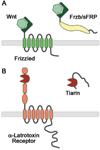Neural plate patterning by secreted signals
- PMID: 11856521
- PMCID: PMC3039547
- DOI: 10.1016/s0896-6273(02)00596-2
Neural plate patterning by secreted signals
Abstract
The patterning of the CNS relies on the interaction of multiple signaling molecules such as Sonic Hedgehog, Wnts, and BMPs and their antagonists Chordin and Noggin. The identification of the secreted molecule Tiarin (Tsuda et al., 2002, this issue of Neuron), produced by the nonneural ectoderm at border of the anterior and lateral neural plate, now introduces a novel signaling pathway participating in CNS development.
Figures


Comment on
-
Dorsalization of the neural tube by Xenopus tiarin, a novel patterning factor secreted by the flanking nonneural head ectoderm.Neuron. 2002 Feb 14;33(4):515-28. doi: 10.1016/s0896-6273(02)00590-1. Neuron. 2002. PMID: 11856527
References
Publication types
MeSH terms
Substances
Grants and funding
LinkOut - more resources
Full Text Sources

